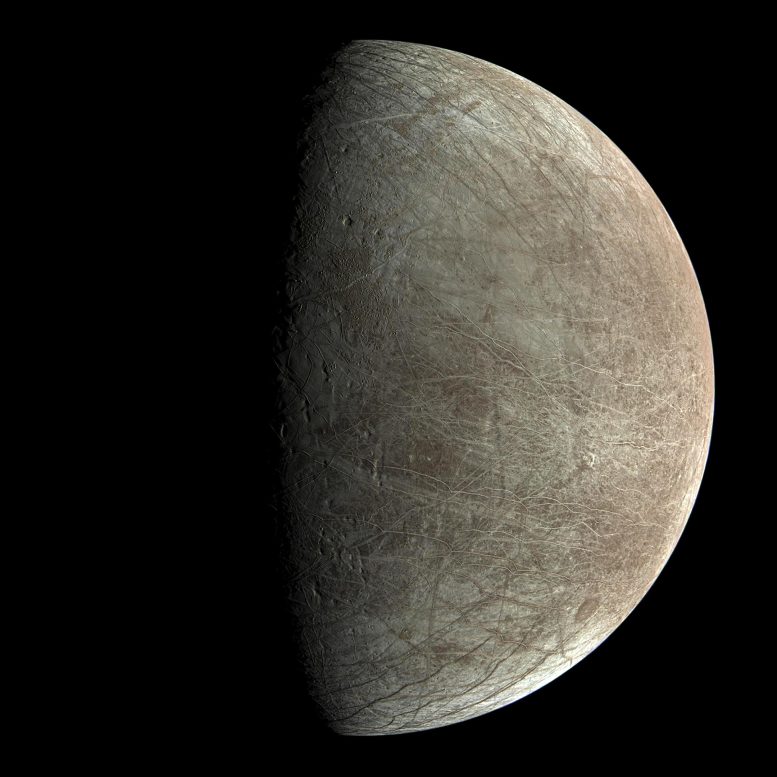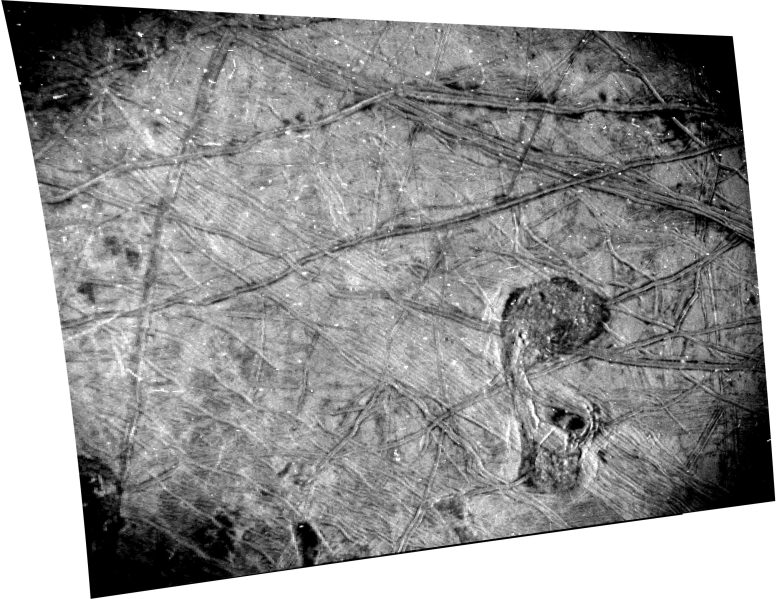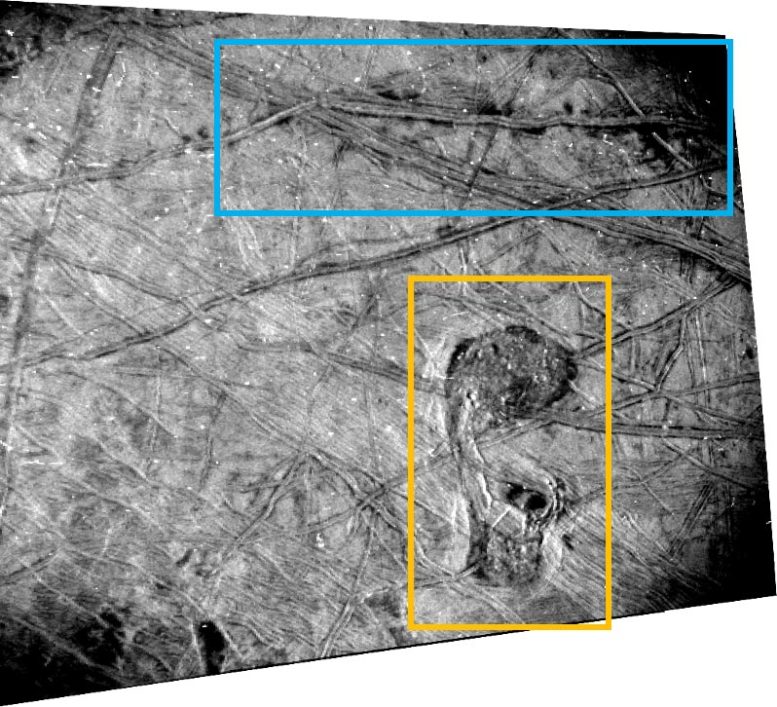
NASA’s Juno has provided images that support the theory of true polar wander on Europa, showing the moon’s ice shell has shifted. Images from the solar-powered spacecraft revealed intriguing features on the ice-encased Jovian moon, including geological disruptions and potential plume activity, suggesting liquid water and brine reaching the surface.
Images captured by the JunoCam visible-light camera aboard NASA’s Juno spacecraft support the theory that the icy crust at the north and south poles of Jupiter’s moon Europa is not where it used to be. Additionally, a high-resolution image from the spacecraft’s Stellar Reference Unit (SRU) shows indications of possible plume activity and disruptions in the ice shell, suggesting that brine may have recently bubbled to the surface.
The JunoCam results were recently published in the Planetary Science Journal and the SRU results were published in the journal JGR Planets.
On September 29, 2022, Juno made its closest flyby of Europa, coming within 220 miles (355 kilometers) of the moon’s frozen surface. The four pictures taken by JunoCam and one by the SRU are the first high-resolution images of Europa since Galileo’s last flyby in 2000.
True Polar Wander
Juno’s ground track over Europa allowed imaging near the moon’s equator. When analyzing the data, the JunoCam team found that along with the expected ice blocks, walls, scarps, ridges, and troughs, the camera also captured irregularly distributed steep-walled depressions 12 to 31 miles (20 to 50 kilometers) wide. They resemble large ovoid pits previously found in imagery from other locations of Europa.
A giant ocean is thought to reside below Europa’s icy exterior, and these surface features have been associated with “true polar wander,” a theory that Europa’s outer ice shell is essentially free-floating and moves.

“True polar wander occurs if Europa’s icy shell is decoupled from its rocky interior, resulting in high stress levels on the shell, which lead to predictable fracture patterns,” said Candy Hansen, a Juno co-investigator who leads planning for JunoCam at the Planetary Science Institute in Tucson, Arizona. “This is the first time that these fracture patterns have been mapped in the southern hemisphere, suggesting that true polar wander’s effect on Europa’s surface geology is more extensive than previously identified.”
The high-resolution JunoCam imagery has also been used to reclassify a formerly prominent surface feature from the Europa map.
“Crater Gwern is no more,” said Hansen. “What was once thought to be a 13-mile-wide impact crater — one of Europa’s few documented impact craters — Gwern was revealed in JunoCam data to be a set of intersecting ridges that created an oval shadow.”

The Platypus
Although all five Europa images from Juno are high-resolution, the image from the spacecraft’s black-and-white SRU offers the most detail. Designed to detect dim stars for navigation purposes, the SRU is sensitive to low light. To avoid over-illumination in the image, the team used the camera to snap the nightside of Europa while it was lit only by sunlight scattered off Jupiter (a phenomenon called “Jupiter-shine”).
This innovative approach to imaging allowed complex surface features to stand out, revealing intricate networks of cross-cutting ridges and dark stains from potential plumes of water vapor. One intriguing feature, which covers an area 23 miles by 42 miles (37 kilometers by 67 kilometers), was nicknamed by the team “the Platypus” because of its shape.
Characterized by chaotic terrain with hummocks, prominent ridges, and dark reddish-brown material, the Platypus is the youngest feature in its neighborhood. Its northern “torso” and southern “bill” — connected by a fractured “neck” formation — interrupt the surrounding terrain with a lumpy matrix material containing numerous ice blocks that are 0.6 to 4.3 miles (1 to 7 kilometers) wide. Ridge formations collapse into the feature at the edges of the Platypus.
For the Juno team, these formations support the idea that Europa’s ice shell may give way in locations where pockets of briny water from the subsurface ocean are present beneath the surface.
About 31 miles (50 kilometers) north of the Platypus is a set of double ridges flanked by dark stains similar to features found elsewhere on Europa that scientists have hypothesized to be cryovolcanic plume deposits.
“These features hint at present-day surface activity and the presence of subsurface liquid water on Europa,” said Heidi Becker, lead co-investigator for the SRU at NASA’s Jet Propulsion Laboratory in Southern California, which also manages the mission. “The SRU’s image is a high-quality baseline for specific places NASA’s Europa Clipper mission and ESA’s (European Space Agency’s) Juice missions can target to search for signs of change and brine.”
Europa Clipper’s focus is on Europa — including investigating whether the icy moon could have conditions suitable for life. It is scheduled to launch on the fall of 2024 and arrive at Jupiter in 2030. Juice (Jupiter Icy Moons Explorer) launched on April 14, 2023. The ESA mission will reach Jupiter in July 2031 to study many targets (Jupiter’s three large icy moons, as well as fiery Io and smaller moons, along with the planet’s atmosphere, magnetosphere, and rings) with a special focus on Ganymede.
Juno executed its 61st close flyby of Jupiter on May 12. Its 62nd flyby of the gas giant, scheduled for June 13, includes an Io flyby at an altitude of about 18,200 miles (29,300 kilometers).
References:
“Juno’s JunoCam Images of Europa” by C. J. Hansen, M. A. Ravine, P. M. Schenk, G. C. Collins, E. J. Leonard, C. B. Phillips, M. A. Caplinger, F. Tosi, S. J. Bolton and Björn Jónsson, 21 March 2024, The Planetary Science Journal.
DOI: 10.3847/PSJ/ad24f4
Reference: “A Complex Region of Europa’s Surface With Hints of Recent Activity Revealed by Juno’s Stellar Reference Unit” by Heidi N. Becker, Jonathan I. Lunine, Paul M. Schenk, Meghan M. Florence, Martin J. Brennan, Candice J. Hansen, Yasmina M. Martos, Scott J. Bolton and James W. Alexander, 22 December 2023, Journal of Geophysical Research: Planets.
DOI: 10.1029/2023JE008105
JPL, a division of Caltech in Pasadena, California, manages the Juno mission for the principal investigator, Scott Bolton, of the Southwest Research Institute in San Antonio. Juno is part of NASA’s New Frontiers Program, which is managed at NASA’s Marshall Space Flight Center in Huntsville, Alabama, for the agency’s Science Mission Directorate in Washington. The Italian Space Agency (ASI) funded the Jovian InfraRed Auroral Mapper. Lockheed Martin Space in Denver built and operates the spacecraft.